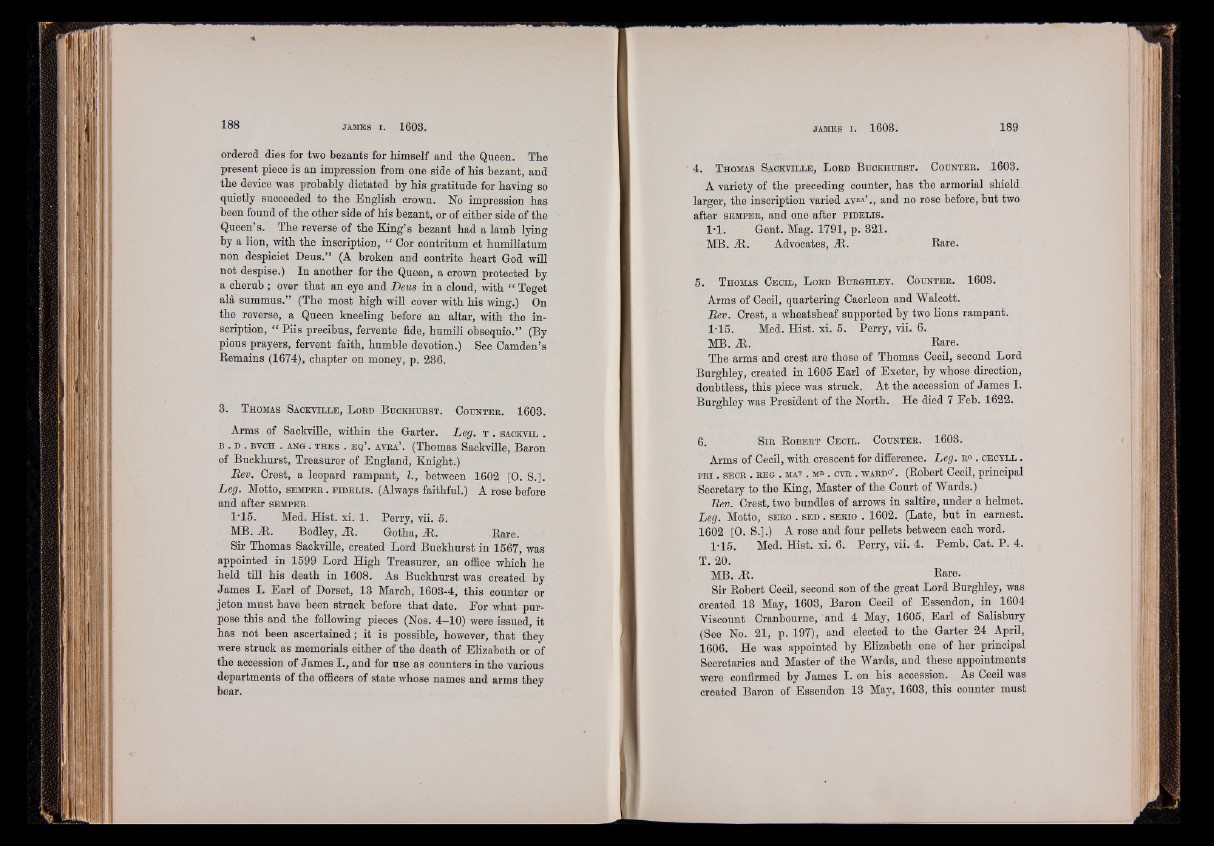
ordered dies for two bezants for himself and the Queen. The
present piece is an impression from one side of his bezant, and
the device was probably dictated by his gratitude for having so
quietly succeeded to the English crown. No impression has
been found of the other side of his bezant, or of either side of the
Queen’s. The reverse of the Kang’s bezant had a lamb lying
by a lion, with the inscription, “ Cor contritum et humiliatum
non despieiet Deus.” (A broken and contrite heart God will
not despise.) In another for the Queen, a crown protected by
a cherub ; over that an eye and Deus in a cloud, with “ Teget
ala summus.” (The most high will cover with his wing.) On
the reverse, a Queen kneeling before an altar, with the inscription,
“ Piis precibus, fervente fide, humili obsequio.” (By
pious prayers, fervent faith, humble devotion.) See Camden’s
Remains (1674), chapter on money, p. 286.
3. T h om a s S a c k v i l l e , L o e d B u c k h u r s t . C o u n t e r . 1603.
Arms of Sackville, within the Garter. Leg. t . s a c k v il .
b . d . b v c h . a n g . t h e s . e q ’ . a v r a ’ . (Thomas Sackville, Baron
of Buckhurst, Treasurer of England, Knight.)
Rev. Crest, a leopard rampant, I., between 1602 [0. S.].
Leg. Motto, s e m p e r . e i d e l i s . (Always faithful.) A rose before
and after s em p e r .
1'15. Med. Sist. xi. 1 . Perry, vii. 5.
MB. At. Bodley, At. Gotha, At. Rare.
Sir Thomas Sackville, created Lord Buckhurst in 1567, was
appointed in 1599 Lord High Treasurer, an office which he
held till his death in 1608. As Buckhurst was created by
James I. Earl of Dorset, 13 March, 1603-4, this counter or
jeton must have been struck before that date. For what purpose
this and the following pieces (Nos. 4-10) were issued, it
has not been ascertained; it is possible, however, that they
were struck as memorials either of the death of Elizabeth or of
the accession of James I., and for use as counters in the various
departments of the officers of state whose names and arms they
bear.
■ 4. T h om a s S a c k v i l l e , L o r d B u c k h u r s t . C o u n t e r . 1603.
A variety of the preceding counter, has the armorial shield
larger, the inscription varied a v ha’ ., and no rose before, but two
after s e m p e r , and one after f i d e l i s .
P I . Gent. Mag. 1791, p. 321.
MB. At. Advocates, At. Rare.
5. T h om a s C e c i l , L o r d B u r g h l e v . C o u n t e r . 1603.
Arms of Cecil, quartering Caerleon and Walcott.
Rev. Crest, a wheatsheaf supported by two lions rampant.
1-15. Med. Hist. xi. 5. Perry, vii. 6.
MB. At. Rare.
The arms and crest are those of Thomas Cecil, second Lord
Burghley, created in 1605 Earl of Exeter, by whose direction,
doubtless, this piece was struck. At the accession of James I.
Burghley was President of the North. He died 7 Feb. 1622.
6. S i r R o b e r t C e c i l . C o u n t e r . 1603.
Arms of Cecil, with crescent for difference. Leg. r ° . c e c y l l .
p r i . s e c r . b e g . mat . ME . cvR . w a r d 0’ . (Robert Cecil, principal
Secretary to the King, Master of the Court of Wards.)
Rev. Crest, two bundles of arrows in saltire, under a helmet.
Leg. Motto, s e r o . s e d . s e r i o . 1602. (Late, but in earnest.
1602 [O. S.].) A rose and four pellets between each word.
1-15. Med. Hist. xi. 6. Perry, vii. 4. Pemb. Cat. P. 4.
T. 20.
MB. At. Rare.
Sir Robert Cecil, second son of the great Lord Burghley, was
created 13 May, 1603, Baron Cecil of Essendon, in 1604
Viscount Cranbourne, and 4 May, 1605, Earl of Salisbury
(See No. 21, p. 197), and elected to the Garter 24 April,
1606. He was appointed by Elizabeth one of her principal
Secretaries and Master of the Wards, and these appointments
were confirmed by James I. on his accession. As Cecil was
created Baron of Essendon 13 May, 1603, this counter must